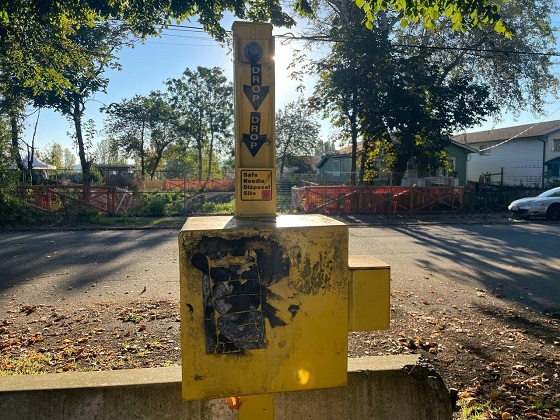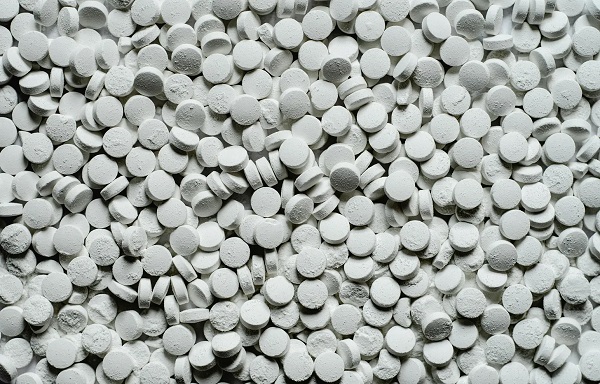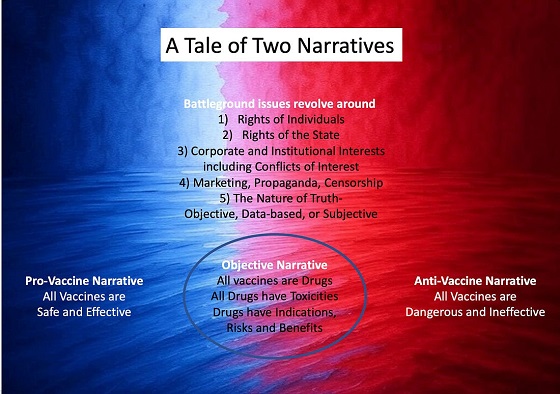Addictions
Nanaimo syringe stabbing reignites calls for involuntary care

Safe needle disposal box at Deverill Square Gyro 2 Park in Nanaimo, B.C., Sept. 5, 2024. [Photo credit: Alexandra Keeler]
By Alexandra Keeler
Some politicians, police and community groups argue involuntary care is key to addressing severe addiction and mental health issues
The brutal stabbing last month of a 58-year-old city employee in Nanaimo, B.C., made national headlines. The man was stabbed multiple times with a syringe after he asked two men who were using drugs in a public park washroom to leave.
The worker sustained multiple injuries to his face and abdomen and was hospitalized. As of Jan. 7, the RCMP were still investigating the suspects.
The incident comes on the heels of other violent attacks in the province that have been linked to mental health and substance use disorders.
On Dec. 4, Vancouver police fatally shot a man armed with a knife inside a 7-Eleven after he attacked two staff members while attempting to steal cigarettes. Earlier that day, the man had allegedly stolen alcohol from a nearby restaurant.
Three months earlier, on Sept. 4, a 34-year-old man with a history of assault and mental health problems randomly attacked two men in downtown Vancouver, leaving one dead and another with a severed hand.
These incidents have sparked growing calls from politicians, police and residents for governments to expand involuntary care and strengthen health-care interventions and law enforcement strategies.
“What is Premier Eby, the provincial and federal government going to do?” the volunteer community group Nanaimo Area Public Safety Association said in a Dec. 11 public statement.
“British Columbians are well past being fed-up with lip-service.”
Our content is always free. Subscribe to get BTN’s latest news and analysis, or donate to our journalism fund.
‘Extremely complex needs’
On Jan. 5, B.C.’s newly reelected premier, David Eby, announced the province will open two involuntary care sites this spring. One will be located at the Surrey Pretrial Centre in Surrey, and the other at the Alouette Correctional Facility in Maple Ridge, a city northeast of Vancouver.
Eby said his aim is to address the cases of severe addiction, brain injury and mental illness that have contributed to violent incidents and public safety concerns.
Involuntary care allows authorities to mandate treatment for individuals with severe mental health or substance use disorders without their consent.
Amy Rosa, a BC Ministry of Health public affairs officer, confirmed to Canadian Affairs that the NDP government remains committed to expanding both voluntary and involuntary care as a solution to the rise in violent attacks.
“We’re grappling with a growing group of people with extremely complex needs — people with severe mental health and addictions issues, coupled with brain injuries from repeated overdoses,” Rosa said.
As part of its commitment to expanding involuntary care, the province plans to establish more secure facilities and mental health units within correctional centres and create 400 new mental health beds.
In response to follow-up questions, Rosa told Canadian Affairs that the province plans to introduce legal changes in the next legislative session “to provide clarity and ensure that people can receive care when they are unable to seek it themselves.” She noted these changes will be made in consultation with First Nations to ensure culturally safe treatment programs.
“The care provided at these facilities will be dignified, safe and respectful,” she said.
 |
Maffeo Sutton Park, where on Dec. 10, 2024, a Nanaimo city worker was stabbed multiple times with a syringe; Sept. 1, 2024. [Photo credit: Alexandra Keeler]
‘Health-led approach’
Nanaimo Mayor Leonard Krog says involuntary care is necessary to prevent violent incidents such as the syringe stabbing in the city’s park.
“Without secure involuntary care, supportive housing, and a full continuum of care from detox to housing, treatment and follow-up, little will change,” he said.
Elenore Sturko, BC Conservative MLA for Surrey-Cloverdale, agrees that early intervention for mental health and substance use disorders is important. She supports laws that facilitate interventions outside of the criminal justice system.
“Psychosis and brain damage are things that need to be diagnosed by medical professionals,” said Sturko, who served as an officer in the RCMP for 13 years.
Sturko says although these diagnoses need to be given by medical professionals, first responders are trained to recognize signs.
“Police can be trained, and first responders are trained, to recognize the signs of those conditions. But whether or not these are regular parts of the assessment that are given to people who are arrested, I actually do not know that,” she said.
Staff Sergeant Kris Clark, a RCMP media relations officer, told Canadian Affairs in an emailed statement that officers receive crisis intervention and de-escalation training but are not mental health professionals.
“All police officers in BC are mandated to undergo crisis intervention and de-escalation training and must recertify every three years,” he said. Additional online courses help officers recognize signs of “mental, emotional or psychological crisis, as well as other altered states of consciousness,” he said.
“It’s important to understand however that police officers are not medical/mental health professionals.”
Clark also referred Canadian Affairs to the BC Association of Chiefs of Police’s Nov. 28 statement. The statement says the association has changed its stance on decriminalization, which refers to policies that remove criminal penalties for illicit drug use.
“Based on evidence and ongoing evaluation, we no longer view decriminalization as a primary mechanism for addressing the systemic challenges associated with substance use,” says the statement. The association represents senior police leaders across the province.
Instead, the association is calling for greater investment in health services, enhanced programs to redirect individuals from the justice system to treatment services, and collaboration with government and community partners.
 |
Vancouver Coastal Health’s Pender Community Health Centre in East Hastings, Vancouver, B.C., Aug. 31, 2024. [Photo credit: Alexandra Keeler]
‘Life or limb’
Police services are not the only agencies grappling with mental health and substance use disorders.
The City of Vancouver told Canadian Affairs it has expanded programs like the Indigenous Crisis Response Team, which offers non-police crisis services for Indigenous adults, and Car 87/88, which pairs a police officer with a psychiatric nurse to respond to mental health crises.
Vancouver Coastal Health, the city’s health authority, adjusted its hiring plan in 2023 to recruit 55 mental health workers, up from 35. And the city has funded 175 new officers in the Vancouver Police Department, a seven per cent increase in the force’s size.
The city has also indicated it supports involuntary care.
In September, Vancouver Mayor Ken Sim was one of 11 B.C. mayors who issued a statement calling on the federal government to provide legal and financial support for provinces to implement involuntary care.
On Oct. 10, Conservative Party Leader Pierre Poilievre said a Conservative government would support mandatory involuntary treatment for minors and prisoners deemed incapable of making decisions.
The following day, Federal Minister of Mental Health and Addictions Ya’ara Saks said in a news conference that provinces must first ensure they have adequate addiction and mental health services in place before discussions about involuntary care can proceed.
“Before we contemplate voluntary or involuntary treatment, I would like to see provinces and territories ensuring that they actually have treatment access scaled to need,” she said.
Some health-care providers have also expressed reservations about involuntary care.
In September, the Canadian Mental Health Association, a national organization that advocates for mental health awareness, issued a news release expressing concerns about involuntary care.
The association highlighted gaps in the current involuntary care system, including challenges in accessing voluntary care, reports of inadequate treatment for those undergoing involuntary care and an increased risk of death from drug poisoning upon release.
“Involuntary care must be a last resort, not a sweeping solution,” its release says.
“We must focus on prevention and early intervention, addressing the root causes of mental health and addiction crises before they escalate into violent incidents.”
Sturko agrees with focusing on early intervention, but emphasized the need for such interventions to be timely.
“We should not have to wait for someone to commit a criminal act in order for them to have court-imposed interventions … We need to be able to act before somebody loses their life or limb.”
This article was produced through the Breaking Needles Fellowship Program, which provided a grant to Canadian Affairs, a digital media outlet, to fund journalism exploring addiction and crime in Canada. Articles produced through the Fellowship are co-published by Break The Needle and Canadian Affairs.
Our content is always free – but if you want to help us commission more high-quality journalism, consider getting a voluntary paid subscription.
2025 Federal Election
Poilievre to invest in recovery, cut off federal funding for opioids and defund drug dens

From Conservative Party Communications
Poilievre will Make Recovery a Reality for 50,000 Canadians
Conservative Leader Pierre Poilievre pledged he will bring the hope that our vulnerable Canadians need by expanding drug recovery programs, creating 50,000 new opportunities for Canadians seeking freedom from addiction. At the same time, he will stop federal funding for opioids, defund federal drug dens, and ensure that any remaining sites do not operate within 500 meters of schools, daycares, playgrounds, parks and seniors’ homes, and comply with strict new oversight rules that focus on pathways to treatment.
More than 50,000 people have lost their lives to fentanyl since 2015—more Canadians than died in the Second World War. Poilievre pledged to open a path to recovery while cracking down on the radical Liberal experiment with free access to illegal drugs that has made the crisis worse and brought disorder to local communities.
Specifically, Poilievre will:
- Fund treatment for 50,000 Canadians. A new Conservative government will fund treatment for 50,000 Canadians in treatment centres with a proven record of success at getting people off drugs. This includes successful models like the Bruce Oake Recovery Centre, which helps people recover and reunite with their families, communities, and culture. To ensure the best outcomes, funding will follow results. Where spaces in good treatment programs exist, we will use them, and where they need to expand, these funds will allow that.
- Ban drug dens from being located within 500 metres of schools, daycares, playgrounds, parks, and seniors’ homes and impose strict new oversight rules. Poilievre also pledged to crack down on the Liberals’ reckless experiments with free access to illegal drugs that allow provinces to operate drug sites with no oversight, while pausing any new federal exemptions until evidence justifies they support recovery. Existing federal sites will be required to operate away from residential communities and places where families and children frequent and will now also have to focus on connecting users with treatment, meet stricter regulatory standards or be shut down. He will also end the exemption for fly-by-night provincially-regulated sites.
“After the Lost Liberal Decade, Canada’s addiction crisis has spiralled out of control,” said Poilievre. “Families have been torn apart while children have to witness open drug use and walk through dangerous encampments to get to school. Canadians deserve better than the endless Liberal cycle of crime, despair, and death.”
Since the Liberals were first elected in 2015, our once-safe communities have become sordid and disordered, while more and more Canadians have been lost to the dangerous drugs the Liberals have flooded into our streets. In British Columbia, where the Liberals decriminalized dangerous drugs like fentanyl and meth, drug overdose deaths increased by 200 percent.
The Liberals also pursued a radical experiment of taxpayer-funded hard drugs, which are often diverted and resold to children and other vulnerable Canadians. The Vancouver Police Department has said that roughly half of all hydromorphone seizures were diverted from this hard drugs program, while the Waterloo Regional Police Service and Niagara Regional Police Service said that hydromorphone seizures had exploded by 1,090% and 1,577%, respectively.
Despite the death and despair that is now common on our streets, bizarrely Mark Carney told a room of Liberal supporters that 50,000 fentanyl deaths in Canada is not “a crisis.” He also hand-picked a Liberal candidate who said the Liberals “would be smart to lean into drug decriminalization” and another who said “legalizing all drugs would be good for Canada.”
Carney’s star candidate Gregor Robertson, an early advocate of decriminalization and so-called safe supply, wanted drug dens imposed on communities without any consultation or public safety considerations. During his disastrous tenure as Vancouver Mayor, overdoses increased by 600%.
Alberta has pioneered an approach that offers real hope by adopting a recovery-focused model of care, leading to a nearly 40 percent reduction in drug-poisoning deaths since 2023—three times the decrease seen in British Columbia. However, we must also end the Liberal drug policies that have worsened the crisis and harmed countless lives and families.
To fund this policy, a Conservative government will stop federal funding for opioids, defund federal drug dens, and sue the opioid manufacturers and consulting companies who created this crisis in the first place.
“Canadians deserve better than the Liberal cycle of crime, despair, and death,” said Poilievre. “We will treat addiction with compassion and accountability—not with more taxpayer-funded poison. We will turn hurt into hope by shutting down drug dens, restoring order in our communities, funding real recovery, and bringing our loved ones home drug-free.”
Addictions
There’s No Such Thing as a “Safer Supply” of Drugs

By Adam Zivo
Sweden, the U.K., and Canada all experimented with providing opioids to addicts. The results were disastrous.
[This article was originally published in City Journal, a public policy magazine and website published by the Manhattan Institute for Policy Research. We encourage our readers to subscribe to them for high-quality analysis on urban issues]
Last August, Denver’s city council passed a proclamation endorsing radical “harm reduction” strategies to address the drug crisis. Among these was “safer supply,” the idea that the government should give drug users their drug of choice, for free. Safer supply is a popular idea among drug-reform activists. But other countries have already tested this experiment and seen disastrous results, including more addiction, crime, and overdose deaths. It would be foolish to follow their example.
The safer-supply movement maintains that drug-related overdoses, infections, and deaths are driven by the unpredictability of the black market, where drugs are inconsistently dosed and often adulterated with other toxic substances. With ultra-potent opioids like fentanyl, even minor dosing errors can prove fatal. Drug contaminants, which dealers use to provide a stronger high at a lower cost, can be just as deadly and potentially disfiguring.
Because of this, harm-reduction activists sometimes argue that governments should provide a free supply of unadulterated, “safe” drugs to get users to abandon the dangerous street supply. Or they say that such drugs should be sold in a controlled manner, like alcohol or cannabis—an endorsement of partial or total drug legalization.
But “safe” is a relative term: the drugs championed by these activists include pharmaceutical-grade fentanyl, hydromorphone (an opioid as potent as heroin), and prescription meth. Though less risky than their illicit alternatives, these drugs are still profoundly dangerous.
The theory behind safer supply is not entirely unreasonable, but in every country that has tried it, implementation has led to increased suffering and addiction. In Europe, only Sweden and the U.K. have tested safer supply, both in the 1960s. The Swedish model gave more than 100 addicts nearly unlimited access through their doctors to prescriptions for morphine and amphetamines, with no expectations of supervised consumption. Recipients mostly sold their free drugs on the black market, often through a network of “satellite patients” (addicts who purchased prescribed drugs). This led to an explosion of addiction and public disorder.
Most doctors quickly abandoned the experiment, and it was shut down after just two years and several high-profile overdose deaths, including that of a 17-year-old girl. Media coverage portrayed safer supply as a generational medical scandal and noted that the British, after experiencing similar problems, also abandoned their experiment.
While the U.S. has never formally adopted a safer-supply policy, it experienced something functionally similar during the OxyContin crisis of the 2000s. At the time, access to the powerful opioid was virtually unrestricted in many parts of North America. Addicts turned to pharmacies for an easy fix and often sold or traded their extra pills for a quick buck. Unscrupulous “pill mills” handed out prescriptions like candy, flooding communities with OxyContin and similar narcotics. The result was a devastating opioid epidemic—one that rages to this day, at a cumulative cost of hundreds of thousands of American lives. Canada was similarly affected.
The OxyContin crisis explains why many experienced addiction experts were aghast when Canada greatly expanded access to safer supply in 2020, following a four-year pilot project. They worried that the mistakes of the recent past were being made all over again, and that the recently vanquished pill mills had returned under the cloak of “harm reduction.”
Subscribe for free to get BTN’s latest news and analysis – or donate to our investigative journalism fund.
Most Canadian safer-supply prescribers dispense large quantities of hydromorphone with little to no supervised consumption. Patients can receive up to 40 eight-milligram pills per day—despite the fact that just two or three are enough to cause an overdose in someone without opioid tolerance. Some prescribers also provide supplementary fentanyl, oxycodone, or stimulants.
Unfortunately, many safer-supply patients sell or trade a significant portion of these drugs—primarily hydromorphone—in order to purchase more potent illicit substances, such as street fentanyl.
The problems with safer supply entered Canada’s consciousness in mid-2023, through an investigative report I wrote for the National Post. I interviewed 14 addiction physicians from across the country, who testified that safer-supply diversion is ubiquitous; that the street price of hydromorphone collapsed by up to 95 percent in communities where safer supply is available; that youth are consuming and becoming addicted to diverted safer-supply drugs; and that organized crime traffics these drugs.
Facing pushback, I interviewed former drug users, who estimated that roughly 80 percent of the safer-supply drugs flowing through their social circles was getting diverted. I documented dozens of examples of safer-supply trafficking online, representing tens of thousands of pills. I spoke with youth who had developed addictions from diverted safer supply and adults who had purchased thousands of such pills.
After months of public queries, the police department of London, Ontario—where safer supply was first piloted—revealed last summer that annual hydromorphone seizures rose over 3,000 percent between 2019 and 2023. The department later held a press conference warning that gangs clearly traffic safer supply. The police departments of two nearby midsize cities also saw their post-2019 hydromorphone seizures increase more than 1,000 percent.
The Canadian government quietly dropped its support for safer supply last year, cutting funding for many of its pilot programs. The province of British Columbia (the nexus of the harm-reduction movement) finally pulled back support last month, after a leaked presentation confirmed that safer-supply drugs are getting sold internationally and that the government is investigating 60 pharmacies for paying kickbacks to safer-supply patients. For now, all safer-supply drugs dispensed within the province must be consumed under supervision.
Harm-reduction activists have insisted that no hard evidence exists of widespread diversion of safer-supply drugs, but this is only because they refuse to study the issue. Most “studies” supporting safer supply are produced by ideologically driven activist-scholars, who tend to interview a small number of program enrollees. These activists also reject attempts to track diversion as “stigmatizing.”
The experiences of Sweden, the United Kingdom, and Canada offer a clear warning: safer supply is a reliably harmful policy. The outcomes speak for themselves—rising addiction, diversion, and little evidence of long-term benefit.
As the debate unfolds in the United States, policymakers would do well to learn from these failures. Americans should not be made to endure the consequences of a policy already discredited abroad simply because progressive leaders choose to ignore the record. The question now is whether we will repeat others’ mistakes—or chart a more responsible course.
Our content is always free –
but if you want to help us commission more high-quality journalism,
consider getting a voluntary paid subscription.
-

 2025 Federal Election2 days ago
2025 Federal Election2 days agoNo Matter The Winner – My Canada Is Gone
-

 2025 Federal Election2 days ago
2025 Federal Election2 days agoASK YOURSELF! – Can Canada Endure, or Afford the Economic Stagnation of Carney’s Costly Climate Vision?
-

 Alberta2 days ago
Alberta2 days agoMade in Alberta! Province makes it easier to support local products with Buy Local program
-

 2025 Federal Election2 days ago
2025 Federal Election2 days agoCSIS Warned Beijing Would Brand Conservatives as Trumpian. Now Carney’s Campaign Is Doing It.
-

 Alberta2 days ago
Alberta2 days agoProvince to expand services provided by Alberta Sheriffs: New policing option for municipalities
-

 2025 Federal Election2 days ago
2025 Federal Election2 days agoInside Buttongate: How the Liberal Swamp Tried to Smear the Conservative Movement — and Got Exposed
-

 Bruce Dowbiggin1 day ago
Bruce Dowbiggin1 day agoIs HNIC Ready For The Winnipeg Jets To Be Canada’s Heroes?
-

 Dr. Robert Malone1 day ago
Dr. Robert Malone1 day agoThe West Texas Measles Outbreak as a Societal and Political Mirror







